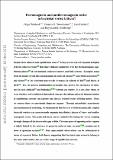Ferromagnetic and antiferromagnetic order in bacterial vortex lattices
Author(s)
Wioland, Hugo; Woodhouse, Francis G.; Goldstein, Raymond E.; Dunkel, Joern
DownloadDunkel_Ferromagnetic and.pdf (1.651Mb)
PUBLISHER_POLICY
Publisher Policy
Article is made available in accordance with the publisher's policy and may be subject to US copyright law. Please refer to the publisher's site for terms of use.
Terms of use
Metadata
Show full item recordAbstract
Despite their inherently non-equilibrium nature [1], living systems can self-organize in highly ordered collective states [2, 3] that share striking similarities with the thermodynamic equilibrium phases [4, 5] of conventional condensed-matter and fluid systems. Examples range from the liquid-crystal-like arrangements of bacterial colonies [6, 7], microbial suspensions [8, 9] and tissues [10] to the coherent macro-scale dynamics in schools of fish [11] and flocks of birds [12]. Yet, the generic mathematical principles that govern the emergence of structure in such artificial [13] and biological [6, 7, 8, 9, 14] systems are elusive. It is not clear when, or even whether, well-established theoretical concepts describing universal thermostatistics of equilibrium systems can capture and classify ordered states of living matter. Here, we connect these two previously disparate regimes: through microfluidic experiments and mathematical modelling, we demonstrate that lattices of hydrodynamically coupled bacterial vortices can spontaneously organize into distinct patterns characterized by ferro- and antiferromagnetic order. The coupling between adjacent vortices can be controlled by tuning the inter-cavity gap widths. The emergence of opposing order regimes is tightly linked to the existence of geometry-induced edge currents [15, 16], reminiscent of those in quantum systems [17, 18, 19]. Our experimental observations can be rationalized in terms of a generic lattice field theory, suggesting that bacterial spin networks belong to the same universality class as a wide range of equilibrium systems.
Date issued
2016-01Department
Massachusetts Institute of Technology. Department of MathematicsJournal
Nature Physics
Citation
Wioland, Hugo, Francis G. Woodhouse, Jörn Dunkel, and Raymond E. Goldstein. “Ferromagnetic and Antiferromagnetic Order in Bacterial Vortex Lattices.” Nature Physics 12, no. 4 (January 4, 2016): 341–345.
Version: Author's final manuscript
ISSN
1745-2473
1745-2481